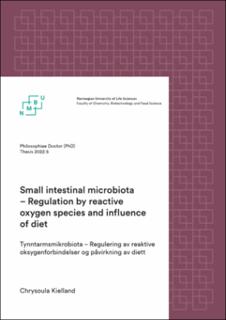| dc.description.abstract | Over the last years multiple studies have analyzed the impact of intestinal microbiota on health. Certain changes in the composition of the microbial population in the intestine have been associated with several diseases including cancer, autoimmune diseases and conditions related to the metabolic syndrome. In many cases, the composition of the gut microbiota has been associated with certain components in the diet. However, most of these studies analyzed either the composition of bacteria in the large intestine or the one in feces. The small intestine (SI) is the organ where absorption of nutrients occurs and is the site where primarily the intestinal microbiota meets the macro- and micronutrients from the diet. Furthermore, the SI possess an enormous number of immune cells and it is known that both dietary compounds and alterations in gut microbial populations can elicit an inflammatory response.
Apart from being responsible for nutrient absorption, the SI, possesses another crucial role; it defends the host from a potential invasion by microorganisms. To achieve that, the small intestine employs several mechanisms including motility and secretion of antimicrobial substances. Reactive Oxygen Species (ROS) are part of the innate immune system and are known to be responsible for the respiratory burst in neutrophils, macrophages, and dendritic cells which reside inside the lamina propria. However, an antimicrobial role of ROS produced by the epithelial cells in the small intestine under steady state is less determined. This work is divided in two parts; first our aim was to elucidate to which extent the small intestinal microbiota (SIM) is inducing the production of ROS in an effort of the host to maintain the microbial homeostasis in the small intestine. In the second part we sought to analyze whether changes in diet would alter the composition of the small intestinal microbiota and consequently if this would impact the state of the immune system. Fat and coffee were the diet compounds that were tested.
Nitric oxide synthases (NOSes) are enzymes catalysing the reaction producing nitric oxide (NO). In this work we focused on the inducible NOS isoform (iNOS). The expression of iNOS is induced among others by bacterial products. NADPH 1 (NOX1) is expressed from the epithelial cells in the small and large intestine and is a catalyst in the production of superoxide. Superoxide reacts with NO to produce peroxynitrite. In vivo imaging revealed very high levels of ROS in the ileum of normal healthy mice which was regulated by the number of intestinal bacteria at this site. In the ileum of iNOS- and NOX1-deficient mice, the bacterial load was higher, and the composition of the bacterial community resembled the one present in cecum. These data suggest a role of ROS produced in the terminal SI as a regulator of the amount and composition of the small intestinal microbiota, possibly contributing against reflux of microbes from the large intestine.
Introduction of a high fat diet (HFD) has been linked with onset of inflammation in the SI. Moreover, studies based on both human and animal models have shown that ingestion of a HFD leads to an unbalanced microbiota composition. Here, based on a mouse model we found that consumption of a HFD led to an unbalanced microbial profile in the SI. SIM in the HFD fed mice was characterized by an increase in the proinflammatory γ-Proteobacteria and Peptoclostridium. Additionally, we observed an increased inflammatory response in the SI characterised by higher production of pro-inflammatory cytokines and higher ratio of pro-inflammatory to anti-inflammatory macrophages.
Coffee is a widely consumed beverage rich in polyphenols that are known to be antiinflammatory. A positive association of diets rich in polyphenols with the colonic gut microbiota has been previously described. In the
current work, we aimed to identify whether the coffee would improve the changes in the intestinal microbiota and in certain inflammatory markers caused by HFD. The results showed that the microbiota in mice fed coffee together with HFD was altered and resembled the one in the mice fed a low-fat diet (LFD). In addition, the mice receiving coffee had a dampened inflammatory response in the SI.
Summing up, here we have shown that a very high ROS production is induced by the bacteria in the terminal SI. These ROS derive from the epithelial cell layer and act as a modulator of microbial homeostasis in the SI. Regarding the impact of high amount of fat in the diet we observed that fat negatively affected the community structure of SIM and the inflammatory status of the host, something that was improved after coffee addition. | en_US |

